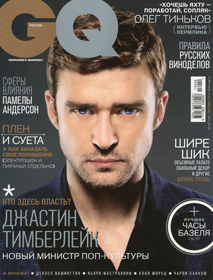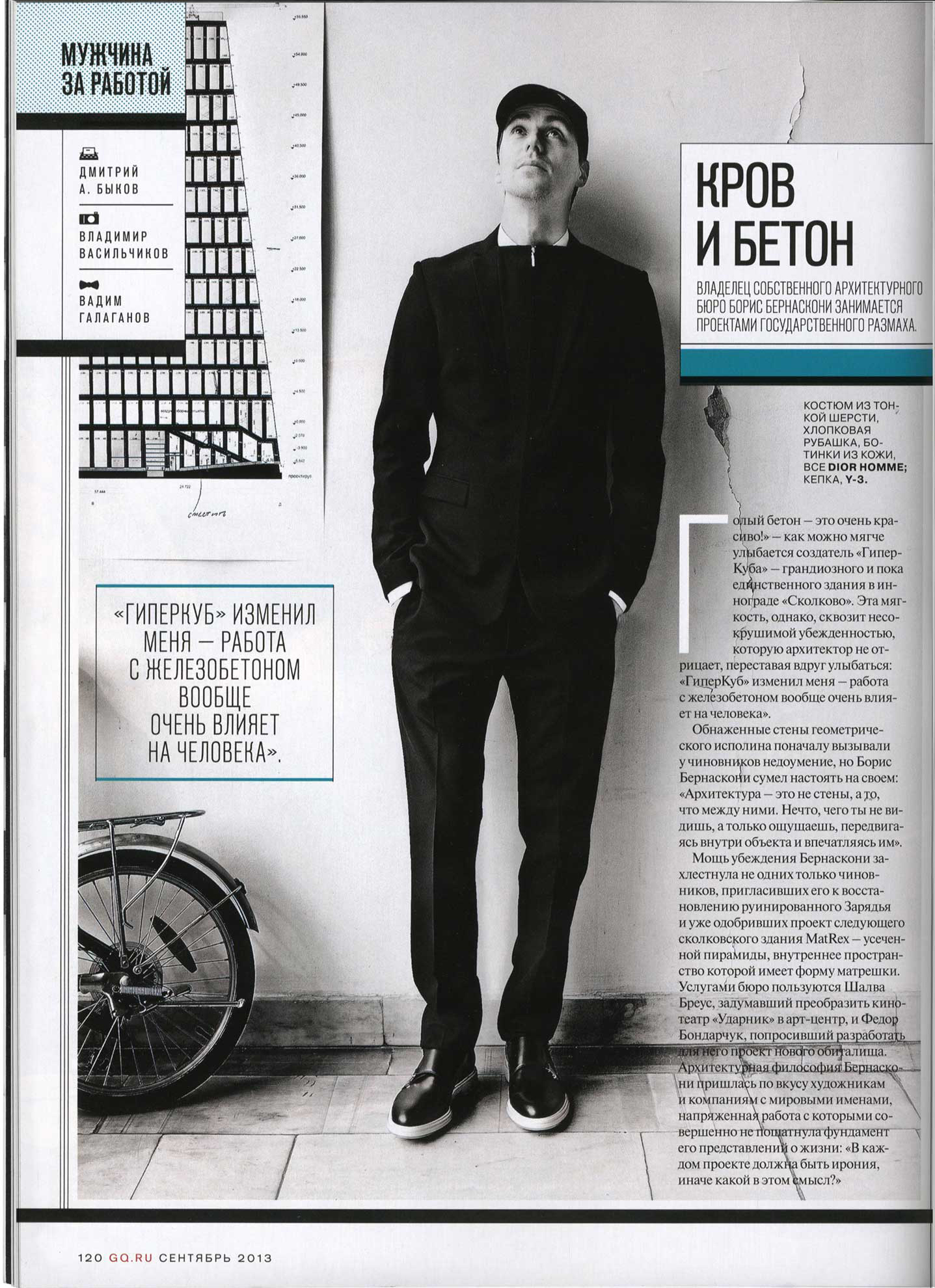
Сентябрь 2013September 2013

«ГИПЕРКУБ» изменил меня – работа с железобетоном вообще очень влияет на человека»“The “Hypercube” has changed me - working with reinforced concrete generally has a great effect on a person.”

«Голый бетон – это очень красиво!» – как можно мягче улыбается создатель «Гиперкуба» – грандиозного и пока единственного здания в иннограде «Сколково». Эта мягкость, однако, сквозит несокрушимой убежденностью, которой архитектор не отрицает, переставая вдруг улыбаться: «Гиперкуб» изменил меня – работа с железобетоном вообще очень влияет на человека».Обнаженные стены геометрического исполина поначалу вызывали у чиновников недоумение, но Борис сумел настоять на своем.Мы решили встретиться с архитектором, чтобы испытать на себе мощь его убеждения, захлестнувшую не одних только чиновников, пригласивших его к участию в конкурсе на восстановление руинированного Зарядья, но и Шалву Бреуса, задумавшего преобразить кинотеатр «Ударник» в арт-центр.
“Naked concrete is quite beautiful!” said the creator of Hypercube – the grandiose, and so far only, building at the Skolkovo Innovation Town – with a gentle smile. But this gentleness gives way to an unshakable conviction, which the architect makes no attempt to deny, and he suddenly ceases to smile: “The Hypercube has changed me - working with reinforced concrete generally has a great effect on a person.” The walls of this geometric giant initially aroused confusion among officials, but Boris stuck to his guns. We had decided to meet with the architect to experience the strength of his conviction, which had got the better not only of the officials who invited him to participate in the competition to restore the ruined Zaryadye, but also of Shalva Breus and his intention to transform the Udarnik cinema into an arts centre.
Как тебе нравится современная Москва?
Мне кажется, что Москва — город, который нельзя испортить.
Все уже и так ужасно?
Нет, ну почему? Архитектура — это такая вещь, которая постоянно обновляется. Бывают моменты чудовищного бардака, но это временно, и среда в конце концов регенерируется. Это как проснуться поутру с больной головой – это ужасно, но ты же не ставишь на этом точку, потому что знаешь: надо съесть аспирину, и все будет в порядке.
Ну нам уже пора принимать аспирин?
Сейчас все не так ужасно, но хотелось бы лучше. Конечно, если обращать пристальное внимание на этот турецкий бежевый керамогранит вокруг, все покажется кошмарным. Но я не смотрю на него, а фокусируюсь только на том, что мне важно.
Ты, видно, оптимистически настроен.
Мне кажется, любой город надо рассматривать положительно, потому что это среда, которая помогает человеку выжить. В тайге, например, очень красиво, но это длится где-то до семи вечера, а дольше тебя съедают заживо. Город же обеспечивает человеку возможность фокусироваться на прекрасном, а в лесу необходимо напряженно всматриваться в ужасное, иначе оно тебя убьет.
Как случилось, что ты стал одним из воплотителей важных госпроектов?
Я вообще рассматриваю архитектуру как некий национальный проект, способ самоидентификации государства, без которого она была бы невозможна. Мое участие в госпроектах – это реализация наших общих с государством задач. Я считаю, что нужно абстрагироваться от всех плохих вещей, которые здесь и сейчас происходят с властью, надо мыслить архитектурной перспективой, а она простирается дальше человеческой жизни.
А что это за проект сиреневого российского флага у тебя на сайте?
Это попытка прорваться сквозь традиции. После падения СССР красный стяг был заменен на старый российский, между прочим, изначально торговый флаг. Я не очень понимаю, почему это произошло. Если мы вступаем в новый виток, то нам нужен и новый флаг. Поэтому мы сделали триколор интерактивным, нестабильным, введя параметр динамики: каждые 4 года должно происходить 15-процентное смешивание цветов. Какой цвет получится в итоге, неизвестно, но ясно, что флаг живет вместе с нами.
Следом за «Гиперкубом» в «Сколково» будет возведено здание MATREX в виде усеченной пирамиды, заключающей внутри пустое пространство в форме матрешки. Откуда такая идея?
Этому проекту уже много лет, но со временем мы ушли от матрешки как объекта и пришли к матрешке-пространству, пустоте. Тут есть гуманитарный месседж: что в архитектуре главное? Многие считают, что это стены или форма. Это не так! Самое главное – то, что находится между стенами. То, чего ты не видишь никогда, а лишь ощущаешь, перемещаясь в этом объекте и впечатляясь им.
Это вроде музыки, где на первом месте не ноты и звуки, а паузы?
Да, а еще — некий код, считывая который, ты получаешь удовлетворение от понимания, как это все работает. Озарение, что ли.
В какой-то момент в интернете появилось твое открытое письмо, в котором ты недвусмысленно предлагал тем участникам сколковского проекта, что затягивали строительство «Гиперкуба», убираться с дороги и не мешать. Кому эти слова были адресованы в первую очередь?
Вообще всем участникам проекта. «Гиперкуб» – это моя инициатива, которая затем превратилась в долгую череду последовательных усилий. Все это вместе представляет труд большого количества людей, которых трудно бывало организовать разом. Пришлось прибегнуть к такому ходу: с одной стороны это было просьбой, с другой – угрозой.
Ты участвуешь в проектировании Золотого острова на «Красном октябре». Какие кардинальные изменения ждут это место по твоей задумке?
Если на «Красном октябре» все продолжится хорошо, он в итоге превратится в элитный район типа Челси. Там есть лофты, будет музей.
Некоторые жалуются — мол, нас лишают арт-кластера ради очередной парковки и элитного жилья.
Не нужно горевать по якобы уходящему оттуда клубному или арт-кластеру. Вся эта реальность временная, добавленная, а дальше уже вступает в силу экономическая необходимость. Это неизбежно, не понимаю, на что тут жаловаться. Все равно, что жаловаться на то, что станешь дедушкой или бабушкой.
Какая судьба ожидает Зарядье?
Нас попросили разработать там проект парка. И для центра Москвы это единственно правильное решение.
А твое предложение заключить церетелевского Петра на «Красном октябре» в оболочку – это ты всерьез?
Вполне. У нас был телемост с Зурабом Константиновичем, я выразил глубочайшее уважение к его профессиональному жанру. Это неутомимый творец, у него есть неплохие живописные работы. Скульптуры его, конечно, специфичны, но это наша реальность. И если вокруг Петра построить музей современного искусства имени Церетели, то он бы выполнял все те задачи, что ставит сегодня Капков. Это такой аттракцион, который делается не сложнее американских горок.
Так есть в этом ирония?
Архитектуре необходима ирония, иначе зачем все это нужно?
How do you like modern Moscow?
I think Moscow is a city that cannot be spoiled.
You mean it’s all already so terrible it can’t get any worse?
Not at all, why would you say that? Architecture is something that’s constantly renewing itself. There are some hideous moments of chaos, but this is temporary, and the environment will eventually regenerate. It’s like waking up in the morning with a bad head – it’s awful, but you don’t stop there: you know you just need to take an aspirin, and everything will be alright.
Is it time for us to take an aspirin then?
It’s not all that terrible now, but it could be better. Of course, if you pay too much attention to this beige Turkish porcelain tiling that’s all over the place, everything might seem dreadful. But I don’t look at it; I focus only on what’s important to me.
You seem optimistic.
It seems to me that any city needs to be viewed positively, because it’s an environment that aids human survival. In the forests of the taiga, for example, it’s very beautiful, but this only lasts until about seven in the evening, after which you might get eaten alive. The city also provides you with the opportunity to focus on the beautiful, while in the woods you need to look intensely at the horrible, or else it will kill you.
How did you end up realising important state projects?
In general, I view architecture as a kind of national project, as a means for the state to achieve self-identification, without which it couldn’t exist. My participation in state projects is the realisation of our common objectives with the state. I believe you need to step back a bit from all the bad things going on here and now with the authorities, you need to think about the architectural perspective, and this is something that extends beyond any human life span.
And what’s the deal with that project for the lilac Russian flag on your website?
It’s an attempt to break through traditions. After the fall of the Soviet Union, the red flag was replaced by the old Russian one, which, by the way, was originally a merchant ensign. I don’t really understand why this happened. If we’re really to take a new turn, then we need a new flag. So we made the tricolour interactive and unstable, introducing a dynamic dimension: every 15 years bringing another 15 per cent blending of the colours. What colour we ultimately get is unknown, but it’s clear that the flag is living along with ourselves.
Following in the wake of the Hypercube, the MATREX building will also be erected at Skolkovo, taking the form of a truncated pyramid enclosing an empty space in the form of a wooden Matryoshka doll. Where did this idea come from?
The project has been around for many years, but over time we left behind the Matryoshka as an object and came to the Matryoshka as a space, a void. There’s a humanitarian message in this: What’s the main thing in architecture? Many believe it’s a wall or a form. This isn’t true! The most important thing is what’s found between the walls. That which you never see, but only feel when you move around inside an object and are impressed by it.
It’s something like music, where the pauses take first place rather than the notes and sounds?
Yes, but something else too – a kind of code that you get satisfaction from when you read it and understand how it all works. When it suddenly dawns on you, as it were.
At some point your open letter appeared on the Internet, in which you unambiguously suggested that those participants in the Skolkovo project who were delaying the construction of Hypercube get out of the way and stop causing obstructions. Who were these words addressed to primarily?
To all the participants of the project in general. Hypercubewas my initiative, and then turned into a long struggle. It represents the cumulative work of a large number of people who were difficult to organise all at once. I had to resort to such a move: on the one hand it was a request, but on the other – a threat.
You’re taking part in the design of the Golden Island at the old Red October chocolate factory. What cardinal changes await this place according to your vision for it?
If Red Octobercontinues the way it’s going, it’ll eventually turn into an elite area like Chelsea. There are lofts there, and a museum is on its way.
Some complain, saying we’re losing an art cluster for the sake of another car park and luxury housing development.
You shouldn’t grieve over the supposed loss of some club or arts cluster. Our entire reality is temporary, something supplementary, and then economic necessity comes into force. This is inevitable, I don’t understand what there is to complain about. It’s like complaining about becoming a grandparent.
What fate awaits the Zaryadye district?
We were asked to develop a park project there. And this is the only correct decision for the centre of Moscow.
What about your proposal to encase Tsereteli’s Peter the Great monument at Red October in some kind of shell – was that serious?
Completely. I had a teleconference with Zurab Konstantinovich, and I expressed the deepest respect for his professional genre. He is an indefatigable creator, and has some good painted works. His sculptures, of course, are quite peculiar, but this is the reality we live in. And if a museum of contemporary art named after Tsereteli were to be built around Peter, this would meet all the goals the Moscow city government has set. It would be a great attraction, and no harder to construct than a simple roller coaster.
So there is irony in it?
Architecture needs irony, otherwise why is any of this necessary at all?